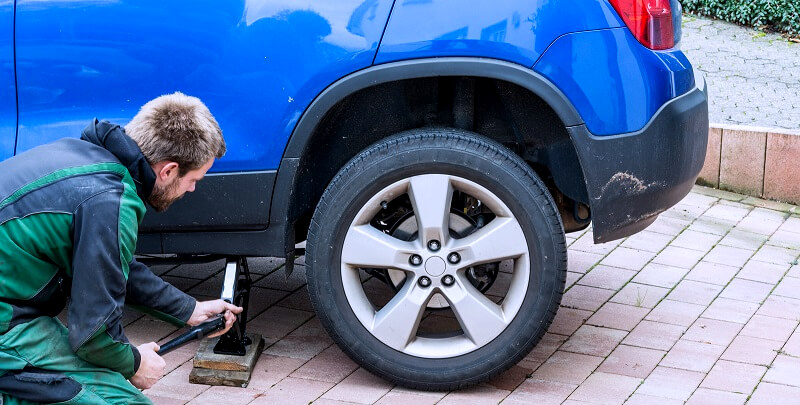Tire Balancing Guide

Tire balancing is essential to vehicle maintenance, ensuring a smooth and safe driving experience. It involves the equal distribution of weight around a tire’s circumference, which helps maintain even contact with the road.
The process of tire balancing is crucial for optimal tire performance and longevity. We will discuss the importance of tire balancing, the signs that your tires are unbalanced, the balancing process, and the recommended frequency of tire balancing.
How Tire Balancing Works?
The balancing process involves two main steps:
- The tire and wheel assembly are placed on a balancing machine, which measures the weight distribution around the tire’s circumference. The machine then identifies any imbalances and calculates the amount of correction needed.
- Once the imbalance has been identified, small weights are added to the wheel’s rim to counteract the uneven weight distribution. The tire and wheel are then retested to ensure proper balance has been achieved.
Signs of Unbalanced Tires
There are several indicators that your tires may be unbalanced, including:
- Vibrations while driving: One of the most noticeable signs of unbalanced tires is a distinct vibration felt. This can occur at certain speeds and may worsen as you accelerate.
- Uneven tire wear: Unbalanced tires can lead to uneven tire wear, where one part of the tire wears out faster than the others. This can significantly reduce the life of your tires and may lead to poor handling, reduced fuel efficiency, and increased risk of blowouts.
- Steering wheel vibration: An unbalanced tire can cause your steering wheel to vibrate, especially at high speeds. This may become more pronounced over time as the imbalance worsens.
How Often Should You Balance Your Tires?
The recommended frequency of tire balancing varies depending on various factors. However, it’s generally suggested to have your tires balanced every 5,000 to 6,000 miles or during each tire rotation. Factors that may affect the frequency of tire balancing include:
- Driving conditions: Poor road conditions or frequent off-roading can cause your tires to become unbalanced more quickly.
- Tire Quality: Lower-quality tires may not maintain their balance as well as higher-quality ones, necessitating more frequent balancing.
- Vehicle Usage: Heavy loads or frequent high-speed driving can lead to more rapid tire wear and imbalance.
Pros & Cons of DIY Tire Balancing
Pros:
- Cost savings: DIY tire balancing can be more cost-effective, as you won’t need to pay for professional services.
- Learning experience: Balancing your tires yourself can provide valuable hands-on experience with vehicle maintenance.
Cons:
- Time-consuming: The process can be time-consuming, particularly if you don’t have prior experience or the proper equipment.
- Risk of error: Incorrectly balanced tires can lead to reduced performance, uneven wear, and potential safety hazards.
Pros & Cons of Professional Tire Balancing
Pros:
- Expertise: Professionals have the skills, experience, and equipment to balance your tires accurately.
- Convenience: Taking your vehicle to a professional saves time and effort compared to doing it yourself.
Cons:
- Cost: Depending on the shop and location, professional tire balancing services can be more expensive than DIY options.
Cost Comparison
While the cost of DIY tire balancing can be significantly lower, it’s essential to consider the investment in the necessary equipment, such as a balancing machine and weights. Professional tire balancing services typically range from $40 to $100, depending on the type of vehicle and the location of the service center.
Do Tires Need To Be Balanced When Rotated?
Tire balancing and tire rotation are two separate maintenance tasks, but they are often performed together to ensure optimal tire performance and extend tire life. Tire balancing involves correcting any weight imbalances in the tire-wheel assembly to minimize vibrations and uneven tire wear.
Tire rotation, on the other hand, is the process of moving tires to different positions on the vehicle to promote even tread wear across all tires. When you rotate your tires, it is a good opportunity to have them balanced as well. Balancing tires during rotation helps maintain a smooth ride and reduce uneven wear.
However, it is not strictly necessary to balance tires each time they are rotated. If you are not experiencing any vibration issues or noticing uneven wear patterns on your tires, you may choose to skip balancing during rotation. It is recommended, though, to have your tires balanced periodically, depending on your vehicle manufacturer’s guidelines or when you notice signs of imbalance, such as vibrations or uneven wear.
Conclusion
Tire balancing is a critical aspect of vehicle maintenance that ensures a smooth, safe, and efficient driving experience. By understanding the signs of unbalanced tires, knowing the balancing process, and being aware of the recommended frequency for tire balancing, you can make informed decisions about your vehicle’s maintenance.

